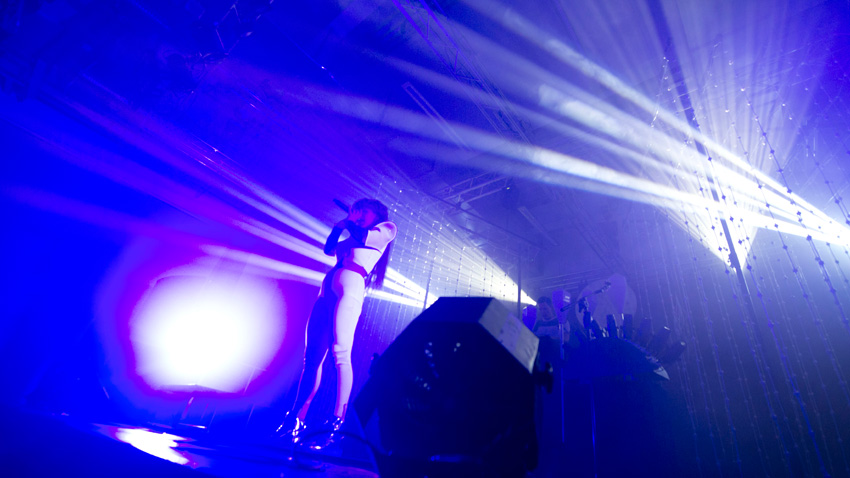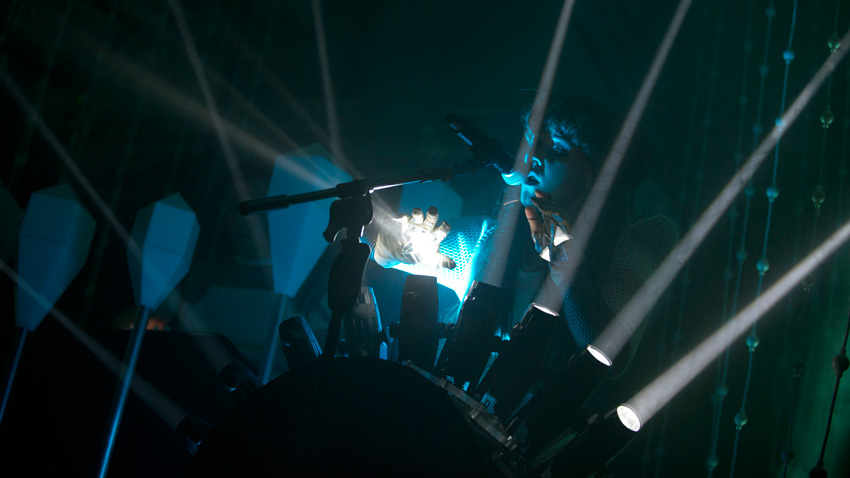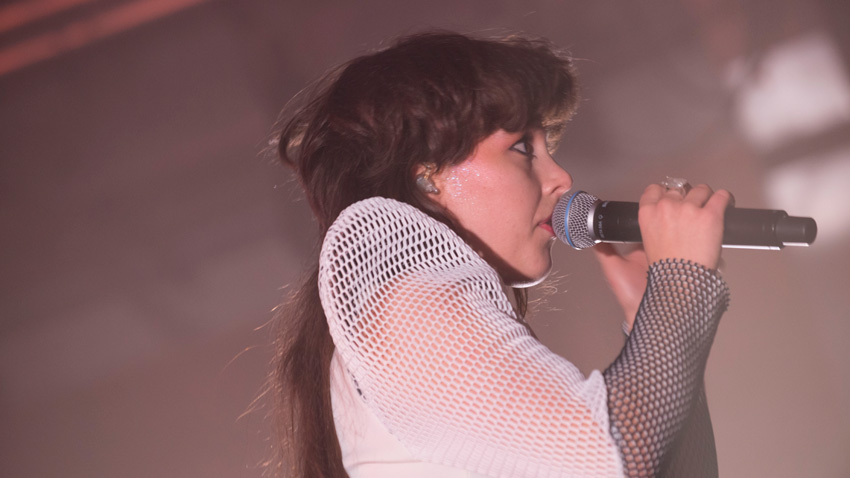Purity Ring: "we've never really given analogue synths the time they deserve"
Corin Roddick explains the duo's meteoric rise

Originally a member of Canadian pop experimentalists Born Gold, Corin Roddick was first introduced to production in 2000. Teaming up with vocalist Megan James, the pair's first track, Ungirthed, was released online in 2011, and just over one year later Purity Ring were signed to UK label 4AD.
When the band's server crashed upon the release of a free download to celebrate the opening of their website, clearly something was stirring. Their debut album, Shrines, was released within months and high profile collaborations followed, with James providing vocals on Jon Hopkins' single Breathe This Air, while the duo got the nod to remix Lady Gaga's 2013 single Applause.
This year, Purity Ring released their second studio album, Another Eternity, supported by a string of concerts across the US and Europe. We caught up with Roddick ahead of soundcheck at one of their UK dates, to find out about the album's creation and check out the band's new custom-built audio-visual live setup.
You both come from the City of Edmonton in Canada. What was it like growing up there?
"Edmonton is a very creative place to grow up, I guess, because it's very northern and very cold for most of the year, so people are often inside. A lot of my friends would hole up and make things; everyone had bands. I grew up as a drummer and drumming was really my main focus for the early part of my life. I was always interested in electronic stuff, but never really delved into it too much. There really wasn't much of an electronic scene in Edmonton that I knew of, but I got to a point where I was sick of playing in bands. I think that was around the time that I got quite interested in the electronic side of things, because I started to see how much of it you could really do yourself, and that was quite appealing to me. All the things you normally need five people for to make a song, I could figure out on my own."
Did anyone inspire you further in the direction of music production?
"Long before I started to try and make anything electronic, Radiohead were always one of my favourite bands. They started to introduce a lot of electronics into their sound around Kid A and everything after that. So that was my first intro to anything vaguely electronic. From there I got into Bjork and a decent amount of hip-hop. A lot of that stuff was quite sample-based and acoustic sounding, but programmed or played on an MPC, so that style of chopping things up interested me as well."
Get the MusicRadar Newsletter
Want all the hottest music and gear news, reviews, deals, features and more, direct to your inbox? Sign up here.

Was the MPC your first step into production?
"Actually, I've never owned an MPC. My intro into electronic production was Ableton. I got a copy from a friend of mine and bought a legit copy later on. That was kind of when I started to see the possibilities of what I could really do, because previously I was interested in recording acoustic things with microphones and I was working in Cubase. Initially, I was running Ableton in Rewire inside of Cubase, just to see what elements I could add, then I started getting more and more interested in Ableton, until I realised I didn't really need Cubase at all. I never actually had any electronic instruments. I made our whole first album using the keypad on my laptop - there's a setting to turn it into a little keyboard controller."
So you never had any experience using hardware synths? Was that mostly down to affordability?
"At the time, it was something that I would have definitely been interested in, but hardware synths are very expensive compared to soft synths, and software was available to me, hardware wasn't. From there, I started to feel really comfortable working with soft synths, so I never actually felt the need to go back and explore the analogue side of things."
Most experienced producers would have started with hardware. For you, we assume using a mouse and software was a completely natural thing?
"If you're coming from using analogue Moogs and changing to a laptop, that would probably not be a very enjoyable transition; but I think I'm in that age range where digital stuff was starting to come up, and, as a 17-year-old, I could actually make sounds this way. I'm looking in a catalogue and there's this synth that looks pretty cool, but it's like $2,000 and huge [laughs]. Still to this day, I've never really given analogue synths the time they probably deserve. I do recognise that they sound different and I could do a lot of different stuff in them, but I like to have a very mobile rig and be able to work seamlessly without having to patch cables around. Maybe years down the road, when I have a very solid studio, I can expand."
Did you leap into making tracks with Ableton Live immediately?
"Definitely. I think a good way to learn is by getting right into it, and if there's something you don't know how to do, you can always look it up on YouTube and figure it out. The first stuff I was doing was quite simple, although I still think I do things quite simply. The best way to learn anything is just to dive right in and develop your style as you're learning, as opposed to completely understanding the whole program. When you don't totally know how to use something, it kind of sets you on a path because you have limited possibilities."
"The first stuff I was doing was quite simple, although I still think I do things quite simply."
When did you have a clear vision of the style of music you wanted to make?
"I didn't have much of a vision; I don't think I'm a visionary person in that way - I'm more mess around, start layering things and see what happens. That's almost always been my approach. On the first tracks I made, there was definitely a hip-hop influence, because that was what I was into when I was drumming, and those rhythms would always draw me in when I was creating programmed beats. Over the years, I guess I developed a catalogue in my head of the sounds that I liked and tried to cultivate those and see how I could morph them into being something unique to me, but I never sit down and know what kind of song I'm going to make."
When did you decide you needed to bring a vocalist in?
"I had known Megan for a few years, because she was also involved in the local music scene. We were both in a backing band for a friend of ours who now goes by the name of Born Gold. We kind of talked about collaborating for a long time; I'd heard her sing and not really known anyone who did something like that. There aren't many people you come across whose talent strikes you in a very unique way. Megan's melodic sensibility, her lyrics and just the tonality of her voice really stood out immediately. Once I started getting comfortable on Ableton, one of the first tracks I made sounded like something I thought would probably work better with vocals. I sent it to Megan and she came up with vocals almost immediately; we put it out a week later and set everything in motion."
You signed to the 4AD label before your first album, Shrines, was even released. Can you tell us about that process?
"From the month that we released that first song, we hand a handful of labels hitting us up, because our stuff was moving around the internet and people were noticing. We still felt like a very new band and only had a couple of songs. Around the time we were completing our first record, we'd been talking to a handful of labels, then 4AD got in touch and were really interested. It came together very quickly and seemed like an obvious choice, but we never sent them any demos - they'd just heard the tracks that we'd already released and were pretty excited about the project."

Did it surprise you how quickly you garnered positive attention from the media?
"It was very surprising, from the very beginning. We weren't really expecting any of it [laughs]. Music was something I was always trying to do for a living, somehow, whether as a recording engineer, a session drummer or even a sound guy. As long as I'm involved in music somehow and can make money that way, I'll be happy. But I really didn't expect it to come so quickly - we're still surprised and haven't got used to it yet."
On your second album, Another Eternity, did you have to think about whether you should stick with the style that made you stand out initially?
"That was definitely a tough decision. If we were a rock band, people would expect us to make another rock album, but when you're electronic, it's expected you're going to stay cutting-edge and relevant, so there's always pressure there.
"I knew that with Shrines we had accomplished the sound that we wanted and used a fairly small sound set to keep the album very unified and consistent. So it took us about a year and a half to really distance ourselves from it and feel like we were fresh and ready to start again. We didn't have a clear idea of what we were going to do this time, but we quickly started to realise that we had evolved a lot as musicians, and that feeling of progression came naturally."
The album's beautifully produced. Would it be fair to say you have a perfectionist approach?
"Yeah, I would say I'm very much a perfectionist. I think that's what draws me in about having a slower tempo. Having a lot of space between the beats, there's an opportunity to really focus in on each element and not have too many things happening on top of each other. I need to feel like I can focus on each element and make it what I want it to be, and having the space to do that is really necessary."
Do you work on the road or a fixed location?
"I've been working more and more in a fixed location, but during the making of our first album we were touring and opening for other bands, so I was working on my laptop a lot and putting stuff together. These days, I'll write a little bit on the road, but it's more comfortable for me to write in a controlled space. I definitely prefer to work with studio monitors; after a couple of hours of working on headphones I start to feel a little bit too closed in, or I'll get ear fatigue. Maybe it's just a question of finding the right headphones. I'm also just weird about ear stuff - my least favourite thing is when people touch my ears; that really bothered me as a kid [laughs]."
What make of monitors do you use?
"I use Barefoot Sound MicroMain27 Gen2 monitors; they're pretty amazing because they have subs built into the sides, and it's really helpful not having to have an additional sub calibrated into my setup. They're about £8000 and massive. When it came to choosing monitors, I did a lot of research and tried a lot of stuff out. I think they work really well for electronic music, because they're very detailed on the mids but have that low-end extension as well. The Gen2s actually come with a little switch that has an emulation of three types of speakers, which is amazing because you have the regular way they sound and then you can change to vintage mode, which is an emulation of Yamaha NS10M monitors; and there's also a micro mode that's an emulation of Avantone's MixCube speakers. So I was constantly switching between
the different speaker sounds to understand how each sound was going to resonate on different
types of speakers."
Are the room acoustics important to you?
"I really care about room acoustics, because a lot of my friends who do electronic production seem much more relaxed about that kind of thing. I go into their setup and it's like, 'How do you work in here?'. Stuff's echoing all over the place and they've got parallel walls. I think it's because I have more of a background in engineering, where I learnt a lot about room acoustics and general studio stuff. I got used to working in nicely treated rooms, so I spent a full week doing all the measurements and fine-tuning the room that I'm working in now until I was really happy with it."
What was your approach to recording Another Eternity?
"Everything is still primarily made within Ableton, with various other third-party plugins. I started recording vocals in PreSonus Studio One because it's really handy for vocal comping and also has Melodyne built in. That was a bit of a game changer when it comes to saving time, recording vocals and then bringing them back into Ableton. That was my big change software wise.
"As I mentioned earlier, on Shrines I worked with a very small and consistent set of sounds, but one of the ways I wanted to expand with the new album was to lift some of those constraints and let each song have a little more freedom, sonically. Instead of having preset choices to pull from, I just went through a lot of stuff and started using what I thought would suit the song instead. So there are a lot of different types of percussion sounds and a broader range of synth tones and reverbs. I think it helped to make the album a bit more diverse, with a little more spread from song to song, without making the tracks disjointed."
"On Shrines I worked with a very small and consistent set of sounds, but one of the ways I wanted to expand with the new album was to lift some of those constraints and let each song have a little more freedom, sonically."
Do you have any favourite effect plugins?
"Yeah, the SoundToys stuff was essential, I used that constantly. EchoBoy and Decapitator were the main ones. I can't really imagine not using that stuff now; they just sound incredible. When it comes to analogue-sounding delay and distortion, which is the toughest thing to do with software, I've tried a lot of different plugins where you need to add a little bit of grittiness or a really warm-sounding echo, and SoundToys is kind of the only thing that's worked for me in that department. There's been a few plugins I've brought in for effects as well, like the Valhalla Shimmer reverb - it's kind of got this crazy, very synthetic sound, which is great when you're not trying to make a real reverb sound. It gives a lot of character and a weird, eerie smoothness. So I used that on a lot of the synths, and I used Sylenth a lot, which is a synth VST that I didn't use the last time. I used it to make a lot of the Moog-like sounds, whereas on Shrines I used the Arturia Moog replicas - but, to me, Sylenth made the Moog-sounding stuff better than the replica. I just found it had a lot more definition and bottom to it."
Did you use Ableton Live's compressors, too?
"I actually started using Ableton Glue Compressor, which they only introduced in the last version. That was really helpful in a lot of scenarios. On the last record I'd used a lot the Waves stuff, but I didn't so much this time; I tried to see if I could tone it down on the effects processing side of things and just use one compressor or one EQ most of the time."
Do you use sidechaining and ducking effects?
"I used a ton of sidechaining on our first album, where a lot of the synths were sidechained to invisible kicks, so it ducks and then there's nothing there - just creating big, empty spaces. I still did that a little bit on the new album, but I definitely toned it down a little and tried to use it more effectively in certain areas rather than it being a constant technique throughout the whole song. I think sidechaining is really helpful in getting a balance between things when you need to make it 'sound' like there's less going on than there really is."

Would you call yourself a sound designer, or do you prefer to arrange from a library of sounds?
"I really do both. I'll definitely mess around for a couple of hours on trying to create my own patch if there's something that I'm trying to find that I can't, but at the same time I have no hate for presets, either. If I find a preset and it sounds like what I'm looking for then I'm not going to try and create something from scratch instead. Sometimes I'm looking for something totally new and that can be a long process; I don't consider myself a pro who knows synthesisers totally in and out. If there's a sound I'm thinking of and I'm trying to create, I can't just do it in five minutes - I usually have to spend some serious time on it, like half a day.
"Sometimes I'll have whole days that I'll dedicate to building libraries and trying to create some new-sounding patches that are easy for me to draw upon later. When I'm feeling creative, the last thing I really want to do is get sidetracked and have to spend a couple of hours digging out a sound."
At what point does Megan come in with the vocals?
"On our first record, it was quite separated. I would basically write a full piece of music, then she would come up with all the vocals - it was more like a stream of consciousness. I find that once vocals are on a track, I'll often need to rearrange them to create a focal point. And that might mean moving something else that was underneath to a different part of the song, or just removing it altogether. I'm not very precious with any part of any track when it comes to trying to make it into an actual song; if it's taking up too much space, I'll gladly get rid of it.
"But for the new album, we actually made more of an effort to collaborate through the whole of the process. A lot of the songs started with a little melody or pattern of some sort, and Megan would add a vocal melody and we would build it up piece by piece. In doing so, we were able to focus more on each individual element of the song and really understand the focal points, have those in the centre and make sure everything else around [them] was working to enhance whatever it was that was important."
"I'm not very precious with any part of any track when it comes to trying to make it into an actual song; if it's taking up too much space, I'll gladly get rid of it."
You remixed the Lady Gaga single Applause. Was it a shock to get that call?
"Yeah, I was definitely surprised to get that call and very happy about it. It was a really cool opportunity. The way I went about it was that, instead of creating a dance or club version of the track - something that a lot of remixes end up being - I came at it more from the angle of just reproducing the track as if I was the person who originally produced it. So I just recreated it as if it were a pop song by her that I would have been involved in, and it was fun to work like that because then it's a totally different context."
Purity Ring's second album, Another Eternity, is out now via 4AD.


Future Music is the number one magazine for today's producers. Packed with technique and technology we'll help you make great new music. All-access artist interviews, in-depth gear reviews, essential production tutorials and much more. Every marvellous monthly edition features reliable reviews of the latest and greatest hardware and software technology and techniques, unparalleled advice, in-depth interviews, sensational free samples and so much more to improve the experience and outcome of your music-making.










